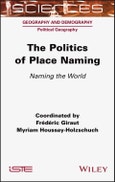Naming the places of the world is an essential human act of territorialization. As the subject of conflict or dispute, naming plays out in numerous ways that involve collective and individual relationships to space, whether functional or imaginary, as well as the identities related to them. Name traces also differ together with their inscription within landscapes and history.
Names constitute a heritage, they bear witness, they mark places and thus contribute to the foundation of territories. Beyond place names, place naming reveals the functions and uses of names, but also the contradictory meanings that society bestows on them.
With this framework in mind, that of critical toponymy, The Politics of Place Naming considers different points of view when studying place naming. These vary from linguistics to political and cultural geography, via history, anthropology, cartography, urban planning, digital humanities, subaltern studies and many other disciplines. This book honors this transversality by taking such studies into account in its examination of place naming.
Table of Contents
Acknowledgements xi
Frédéric GIRAUT and Myriam HOUSSAY-HOLZSCHUCH
Chapter 1 Naming the World: Place-Naming Practices and Issues in Neotoponymy 1
Frédéric GIRAUT and Myriam HOUSSAY-HOLZSCHUCH
1.1 Political/critical toponymy: an emerging field at the core of territorialization issues 2
1.2 Political toponymy: a recent history? 4
1.3 On the agenda of political/critical toponymy: contradictory promotion of functional, market and inclusive corpuses 8
1.4 Theory-in-progress: beyond hegemony and dispositif, a toponymic situationism? 11
1.5 References 18
Chapter 2 Commemorative Place Naming: To Name Places, to Claim the Past, to Repair Futures 29
Derek H ALDERMAN
2.1 A renaming moment in Paris 29
2.2 Place naming as commemorative work 30
2.3 Narrative capacities 32
2.4 Affective capacities 34
2.5 Material capacities 36
2.6 Reparative possibilities and limits 39
2.7 References 42
Chapter 3 The Named, Lived and Contested Environment: Towards a Political Ecology of Toponymy 47
Sébastien BOILLAT
3.1 Introduction 47
3.2 The decline of toponymy as a substitute for archeology 49
3.3 Toponymy and ecology: another divorce, another reconciliation 51
3.4 From cultural heritage to environmental ethics: indigenous place names and beyond 53
3.5 The disputed toponymy: critical perspectives 55
3.6 Towards a political ecology of toponymy 57
3.7 Conclusion 59
3.8 References 60
Chapter 4 Naming the Conquered Territories: Colonies and Empires -- Beneath and Beyond the Exonym/Endonym Opposition 65
Frédéric GIRAUT
4.1 Toponymic colonization of settler frontiers (long-distance metropolitan projections): the fictitious model of the Mysterious Island and its extensions 67
4.2 Toponymic imperialism: the model of Roman super(im)position and Ottoman condescension 77
4.3 Who's in, who's out? Colonial hybridizations and relativity of the concepts of exonym and endonym 81
4.4 References 87
Chapter 5 "Addressing the World": A Political Genealogy of the Street Address 93
Reuben ROSE-REDWOOD, Anton TANTNER and Sun-Bae KIM
5.1 Introduction 93
5.2 Street addressing as a technology of power 94
5.3 Genealogies of the street address 97
5.4 The future of street addressing and the making of a geocoded world 102
5.5 References 104
Chapter 6 Toponymic Commodification: Thematic Brandscapes, Spatial Naming Rights and the Property--Name Nexus 109
Jani VUOLTEENAHO
6.1 Introduction 109
6.2 Thematic namescapes in branding neighborhoods: From Sun Cities to Icebar Saigon and a Brooklyn with distinction 112
6.3 Buying into and contesting spatial naming rights 118
6.4 Discussion: the property--name nexus as a commodification frontier 125
6.5 References 128
Chapter 7 The Toponymy of Tourism and Leisure: General Framework and Lessons from France 135
Christophe GAUCHON
7.1 Introduction 135
7.2 The new names of tourist places 138
7.3 The evolution of the status and uses of toponyms: from designator to brand 140
7.4 Touristic toponymy as an element of territorial restructuring 142
7.5 Conclusion 145
7.6 References 146
Chapter 8 Transport Toponymy: For a Critical Study of the Toponomy of Places of Mobility 149
Lucas DESTREM
8.1 A significant but still understudied fact 150
8.2 Research perspectives 159
8.3 References 170
Chapter 9 The Toponymy of Informal Settlements in the Global South 175
Melissa WANJIRU-MWITA
9.1 Introduction 175
9.2 Toponymy and informality -- a theoretical background 177
9.3 Naming patterns in Nairobi's informal settlements 178
9.4 Actors involved in the toponymy of informal settlements 186
9.5 Conclusion -- towards a toponymic framework for informal settlements 186
9.6 References 187
Chapter 10 The Map, the Name and the Territory: Toponymic Struggles in the Era of Cartographic Post-Sovereignty 191
Matthieu NOUCHER
10.1 Place names, an issue of information sovereignty 191
10.2 Cartographic post-sovereignty and place names: when the geoweb blurs the map 193
10.3 Toponymic struggles of yesterday and today: the exemplary case of Guiana 199
10.4 Research agenda: when the geoweb brings place names into the era of post-sovereignty 210
10.5 References 213
Chapter 11 What Africa Might Contribute to Critical Toponymy 217
Michel BEN ARROUS and Liora BIGON
11.1 Official toponymy and others 219
11.2 A problem of places 226
11.3 A problem of hegemony 235
11.4 Making sense: a heuristic of practices 245
11.5 Final remarks 250
11.6 References 253
Conclusion 261
Myriam HOUSSAY-HOLZSCHUCH and Frédéric GIRAUT
List of Authors 273
Index 275








